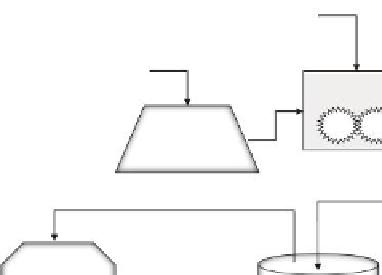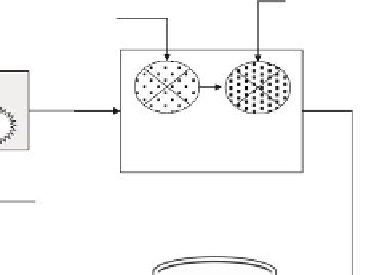Environmental Engineering Reference
In-Depth Information
processes include lime, sodium sulfate, enzymes, tannin, sulfuric acid, ammonium salts,
sodium bicarbonate, linosulfate, trivalent chromium salts, pigments, dyes, resins, formal-
dehyde, glutaraldehyde, and heavy oils. The liquid discharge—i.e., wastewater—from the
various processes has been reported to be from 20 to 80 m
3
/t of hide treated. The composi-
tion of the wastewater contains many of the additives and aids described in the preceding,
with high levels of chromium, sulide, chloride, BOD, and COD. It has been reported that
residues of pesticides from hides have been found in the wastewaters, and because of the
removed fats, unwanted tissue, muscle, hair, skin, and other body meat items, the solid
wastes containing the decaying and decayed body parts pose severe human health threats.
The treatment, handling, and disposal of the liquid and solid wastes are problems that
must be addressed satisfactorily if impact on the geoenvironment is to be avoided. These
will be addressed in Chapter 10.
4.5.2 Pulp and Paper Industry
Wood industries supply building materials, cellulose iber, resins, and other pulp chemi-
cals, and pulp and paper products. By far, the supply of building materials and pulp and
paper products constitute the major portion of the overall wood industries. There is gen-
eral agreement that the many thousands of pulp and paper industries in the world, when
taken as a whole, constitute one of the largest contributors to water, land, and air pollution
problems in the locations of those industries. Figure 4.9 shows a simpliied low diagram
Acid sulfide liquor, or alkaline
sulfate liquor, or neutral sulfite
Fresh water
Reuse
water
Pulpwood logs, reuse
and/or freshwater
Pulping
Pulp
Wood
preparation
Coarse and fine
screening
Bleaching chemicals and
fresh water
Pulp
dryer
Unbleached
pulp
Bleaching
�ickening
Fresh water
Market
pulp
Stock
preparation
Paper
making
Finishing
Fillers, dye, alum, starch
Coating chemicals
FIGURE 4.9
Simple low diagram showing typical pulp and paper processes. Note inputs into the various processes and the
extensive use of freshwater for many of the processes.




Search WWH ::

Custom Search